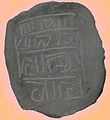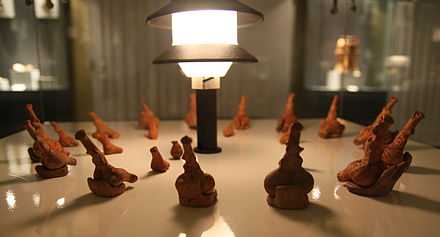Symbols and proto-writing of the Cucuteni–Trypillian culture
A set of symbols depicted on clay artifacts associated with the Vinča culture, which flourished along the Danube River in the Pannonian Plain, between 6000-4000 BC was first noted by Hungarian archaeologist Zsófia Torma ( 1832 – 1899) at the archaeological site in the village of Turdaş, Romania (which was known at the time as Tordos), and consisted of a collection of artifacts that had what appeared to be an unknown system of writing. In 1908, more of these same kind of artifacts were discovered at a site near Vinča, outside of the city of Belgrade, Serbia. Scholars subsequently labeled this the "Vinča Script" or "Vinča-Tordos Script".
The Vinča symbols were also discussed by Marija Gimbutas, who in the 1950s developed her theories that became collectively known as the Old European culture. Gimbutas claimed that these symbols represented an Old European Script that she said was a writing system that predated the Sumerian Cuneiform script. This theory reinforced her claims that the Neolithic civilizations of southeastern Europe were matriarchal, Mother Goddess worshippers, since the symbols were so often found on clay anthropomorphic female fetish figurines that are to be found in archaeological sites throughout the entire region.[1] Her claims have largely been disproven by subsequent research and discoveries,[2] but there are still scholars who support Gimbutas' theories.[3]
Further clouding the issue, there have been several people who have published theories about the Vinča symbols, including one that claims it is the ancient Etruscan alphabet; all of these theories have been disproven by scholars.[2]
The Vinča symbols were found etched or painted on the ubiquitous anthropomorphic female clay statues. These statues have markings on them that appear in roughly the same location (for instance, along the upper arms and shoulders), and are found in various archaeological sites scattered over a wide geographical area.
Beginning in 1875 up to the present, archaeologists have found more than a thousand Neolithic era clay artifacts that have examples of symbols similar to the Vinča symbols scattered widely throughout south-eastern Europe. These include:
- The Tărtăria Tablets, discovered in 1961 in the village of Tărtăria, Săliştea, Alba County, Romania.
- The Gradeshnitsa Tablets, discovered in 1969 in Gradeshnitsa, Vratsa Province, Bulgaria.
- The Dispilio Tablet, discovered in 1994 in Dispilio, Kastoria regional unit, Greece.
- The Cucuteni-Trypillian pintadera (or barter tokens)
There has been some controversy in the dating of some of these discoveries, especially the Tărtăria Tablets.
-
One of the three Tărtăria tablets, dated 5300 BC
-

One of the Gradeshnitsa Tablets
-
Cucuteni-Trypillian barter tokens, or pintadera
In 1981 archaeologists unearthed a remarkable discovery dating back to 4200 BC from the Precucuteni site of Poduri-Dealul, near the town of Ghindaru, Bacău County, Romania. Dubbed the "Council of Goddesses", it was a collection of 15 anthropomorphic female clay figurines, all of whom were seated, with 13 of them seated on accompanying clay chairs (or thrones), all of the figurines were placed so that they were facing inward in a circle (see photograph below). The archaeologists noted that some of these figurines had symbolic markings painted in red on their shoulders, almost identical to other clay female figurines found elsewhere.
- Looking below, the figure to the left has a symbol made of four lines that are connected to a perpendicular line (or bar) located on the right shoulder. Another female figurine found at a Precucuteni site near Târgu Frumos, in Iaşi County, Romania, has an identical symbol, including the placement of it on the figurine's right shoulder. Târgu Frumos is located a linear 88.5 km. (55 miles) from Ghindaru.
- The figurine on the right has a symbol of three lines connected to a bar and placed on the left shoulder, again identical to other Precucuteni female clay figurines found at sites near the villages of Isaiia, Iaşi County, Romania, and Sabatynivka, Ulianovskyi Raion, Kirovohrad Oblast, Ukraine. Isaiia is located 119 km. (74 miles), and Sabatynivka is 333 km (207 mi) from Ghindaru.
Both examples illustrated of these symbols, the three and four lines connected to a bar, are found in other archaeological artifacts from across the region, and are emblematic of the Vinča symbols. However, other researchers posit that these symbols are divinity identifiers, decorations, or generic symbols, rather than signs of a writing system.[3]

Thus it appears that the Vinča or Vinča-Tordos symbols are not restricted to just the region around Belgrade, which is where the Vinča culture existed, but that they spread across most of southeastern Europe, and was used throughout the geographical region of the Cucuteni-Trypillian culture. This "Goddess Council" example is just one of many that supports the widespread use of these symbols among the Neolithic people of this entire area, and presents very compelling evidence to suggest that these symbols were understood by many individuals who lived in different areas, which lends support to the notion that they were indeed examples of proto-writing, if not a rudimentary writing system.
As a result of this widespread use of these patters, historian Marco Merlini has suggested that it be given a name other than Vinča, since this implies that it was only used among the Vinča culture around the Pannonian Plain, at the very western edge of the extensive area where examples of this symbolic system have been discovered. Merlini has proposed naming this system the Danube Script.[4]
References
- ↑ Gimbutas, Marija Alseikaitė (1991), The civilization of the Goddess: the world of Old Europe, San Francisco: HarperSanFrancisco, ISBN 0-06-250368-5, OCLC 123210574
- ↑ 2.0 2.1 Winn, Shan M. Pre-writing in Southeastern Europe: The Sign System of the Vinča Culture ca. 4000 BCE. Calgary: Western Publishers, 1981, p. 15.
- ↑ 3.0 3.1 Merlini, Marco (2009), An Inquiry into the Danube Script, Brukenthal National Museum Foreign Languages Publications, Alba Iulia, Romania: Editura Altip, p. 680
- ↑ Merlini, Marco; Gheorghe Lazarovici (2008). Luca, Sabin Adrian, ed. "Settling discovery circumstances, dating and utilization of the Tărtăria Tablets" (.PDF). Acta Terrae Septemcastrensis. Proceedings of the International Colloquium: The Carpathian Basin and its Role in the Neolithisation of the Balkan Peninsula (Bucharest, Romania: Bucureşti Editura Economica) 8: 111–195. ISSN 1583-1817. OCLC 445461856. Retrieved 17 January 2010.
- Mallory, James P (1989). In search of the Indo-Europeans: language, archaeology and myth. London: Thames and Hudson. ISBN 0-500-05052-X. OCLC 246601873.
External links
| Wikimedia Commons has media related to Tripolye culture. |
| Wikimedia Commons has media related to Cucuteni culture. |
- Archaeological Park Cucuteni The website for the multi-institutional and international project entitled "Archaeological Park Cucuteni", which seeks to reconstruct the museum at Cucuteni, Romania, and to more effectively preserve this valuable heritage site (in English and Romanian).
- Cucuteni Culture The French Government's Ministry of Culture's page on Cucuteni Culture (in English).
- Cucuteni Culture The Romanian Dacian Museum page on Cucuteni Culture (in English).
- The Trypillia-USA-Project The Trypillian Civilization Society homepage (in English).
- Трипільська культура в Україні з колекції «Платар» Ukrainian language page about the Ukrainian Platar Collection of Trypillian Culture.
- Trypillian Culture from Ukraine A page from the UK-based group "Arattagar" about Trypillian Culture, which has many great photographs of the group's trip to the Trypillian Museum in Trypillia, Ukraine (in English).
- The Institute of Archaeomythology The homepage for The Institute of Archaeomythology, an international organization of scholars dedicated to fostering an interdisciplinary approach to cultural research with particular emphasis on the beliefs, rituals, social structure and symbolism of ancient societies. Much of their focus covers topics that relate to the Cucuteni-Trypillian Culture (in English).
- The Vădastra Village Project A living history museum in Romania, supported by many international institutions.
- Donde Comenzo Escritura Trasoxiana A site in Italian.
- http://www.iatp.md/dava/Dava6/Merlini__6_/Merlini__6_4_/merlini__6_4_.html
| ||||||||||||

